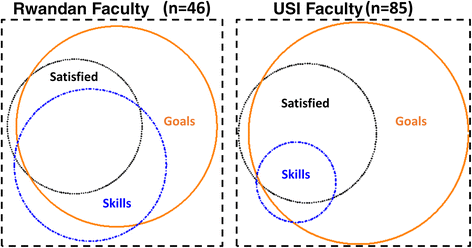Assessing the twinning model in the Rwandan Human Resources for Health Program: goal setting, satisfaction and perceived skill transfer
- PMID: 26822614
- PMCID: PMC4730618
- DOI: 10.1186/s12992-016-0141-4
Assessing the twinning model in the Rwandan Human Resources for Health Program: goal setting, satisfaction and perceived skill transfer
Abstract
Background: Because of the shortage of health professionals, particularly in specialty areas, Rwanda initiated the Human Resources for Health (HRH) Program. In this program, faculty from United States teaching institutions (USF) "twin" with Rwandan Faculty (RF) to transfer skills. This paper assesses the twinning model, exploring USF and RF goal setting, satisfaction and perceptions of the effectiveness of skill transfer within the twinning model.
Methods: All USF and RF in the HRH Program from August 2012-May 2014 were invited to participate. An 85-item questionnaire for USF and 71-item questionnaire for RF were administered via Survey Monkey in April and May 2014. Associations among primary outcomes were assessed and factors related with outcomes were modeled using logistic regression.
Results: Most RF and USF reported setting goals with their twin (89% and 71%, respectively). Half of RF (52%) reported effective skill transfer compared to 10% of USF. Only 38% of RF and 28% of USF reported being very satisfied with the twinning model. There was significant overlap in the three operational outcomes. For RF, the following factors were associated with outcomes: for effective skill transfer, being able to communicate in a common language and working at a nursing site outside of Kigali; and for satisfaction, 7+ years of professional experience and being part of a male RF-female USF twin pair. For USF, the following factors were associated with outcomes: for setting goals, prior teaching experience; and for satisfaction, experience in low resource settings for one month or less and feeling that HRH promotes a culture of respect.
Conclusions: Twinning is the cornerstone of the HRH Program in Rwanda. These findings helped the HRH team identify key areas to improve the twinning experience including better recruitment and orientation of USF and RF, consideration of additional factors during the twinning process, provide language training support, facilitate joint twin activities and cross-cultural training and improve the site leadership buy-in and support of the program. These results can inform other programs using twinning to develop skills in the health workforce.
Figures


Similar articles
-
Health Professional Training and Capacity Strengthening Through International Academic Partnerships: The First Five Years of the Human Resources for Health Program in Rwanda.Int J Health Policy Manag. 2018 Nov 1;7(11):1024-1039. doi: 10.15171/ijhpm.2018.61. Int J Health Policy Manag. 2018. PMID: 30624876 Free PMC article.
-
Building Workforce Capacity Abroad While Strengthening Global Health Programs at Home: Participation of Seven Harvard-Affiliated Institutions in a Health Professional Training Initiative in Rwanda.Acad Med. 2017 May;92(5):649-658. doi: 10.1097/ACM.0000000000001638. Acad Med. 2017. PMID: 28328735
-
ADEA/AAL Institute for Allied Health Educators: Program Evaluation.J Dent Educ. 2015 May;79(5):472-83. J Dent Educ. 2015. PMID: 25941140
-
Evaluation of PEPFAR's Contribution (2012-2017) to Rwanda's Human Resources for Health Program.Washington (DC): National Academies Press (US); 2020 Feb 13. Washington (DC): National Academies Press (US); 2020 Feb 13. PMID: 32584529 Free Books & Documents. Review.
-
Teaching Thoracic Surgery in a Low-Resource Setting:: Creation of a Simulation Curriculum in Rwanda.Thorac Surg Clin. 2022 Aug;32(3):279-287. doi: 10.1016/j.thorsurg.2022.05.001. Thorac Surg Clin. 2022. PMID: 35961736 Review.
Cited by
-
Twinning Partnership Network: A Learning and Experience-Sharing Network Among Health Professionals in Rwanda to Improve Health Services.Glob Health Sci Pract. 2024 Oct 29;12(5):e2300280. doi: 10.9745/GHSP-D-23-00280. Print 2024 Oct 29. Glob Health Sci Pract. 2024. PMID: 39384301 Free PMC article.
-
Human resources for emergency care systems in Ethiopia: Challenges and triumphs.Afr J Emerg Med. 2020;10(Suppl 1):S50-S55. doi: 10.1016/j.afjem.2020.09.006. Epub 2020 Sep 30. Afr J Emerg Med. 2020. PMID: 33318902 Free PMC article.
-
Stronger together: midwifery twinning between Tanzania and Canada.Global Health. 2018 Dec 13;14(1):123. doi: 10.1186/s12992-018-0442-x. Global Health. 2018. PMID: 30545394 Free PMC article. Review.
-
Health Professional Training and Capacity Strengthening Through International Academic Partnerships: The First Five Years of the Human Resources for Health Program in Rwanda.Int J Health Policy Manag. 2018 Nov 1;7(11):1024-1039. doi: 10.15171/ijhpm.2018.61. Int J Health Policy Manag. 2018. PMID: 30624876 Free PMC article.
-
Health professionals' experiences and views on obstetric ultrasound in Rwanda: A cross-sectional study.PLoS One. 2018 Dec 4;13(12):e0208387. doi: 10.1371/journal.pone.0208387. eCollection 2018. PLoS One. 2018. PMID: 30513102 Free PMC article.
References
-
- World health report. Working together for health. Geneva: World Health Organization 2006. [www.who.int/whr/2006/en/index.html]. Accessed 15 Apr 2015.
MeSH terms
LinkOut - more resources
Full Text Sources
Other Literature Sources
Miscellaneous

